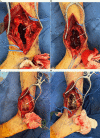Management of Recurrent Giant Cell Tumor of Distal Tibia With Intramedullary Hindfoot Fusion Nail and Trabecular Metal Implant Construct
- PMID: 38725737
- PMCID: PMC11081638
- DOI: 10.7759/cureus.57922
Management of Recurrent Giant Cell Tumor of Distal Tibia With Intramedullary Hindfoot Fusion Nail and Trabecular Metal Implant Construct
Abstract
Reconstruction options for giant cell tumors (GCTs) of bone are limited and challenging due to the amount of structural compromise and the high recurrence rates. This is especially true for GCTs of the foot and ankle, as the area is vital for weight bearing and function. The typical treatment for GCTs is currently excision, curettage, and cementation, although that is not always effective. A 36-year-old otherwise healthy female presented with an original diagnosis of a large aneurysmal bone cyst (ABC) of the distal tibia that had recurred despite two previous attempts at treatment with resection and cementation. She was treated with surgical resection of the lesion, reconstruction, and ankle and subtalar joint arthrodesis with a tibiotalocalcaneal intramedullary nail in combination with a trabecular metal cone. The final pathology of the intraoperative samples was consistent with GCT. Postoperatively, she recovered well, and her imaging was consistent with a successful fusion. This case report provides evidence that tibiotalocalcaneal fusion with a unique combination of hindfoot nail and trabecular metal cone construct in a single procedure is a successful option for the treatment of large, recurrent GCT lesions in the distal tibia.
Keywords: aneurysmal bone cyst; ankle arthritis; distal tibia; foot and ankle reconstruction; giant-cell tumor of bone; tibiotalocalcaneal nail; tumor recurrence.
Copyright © 2024, Callan et al.
Conflict of interest statement
The authors have declared financial relationships, which are detailed in the next section.
Figures









References
-
- Giant cell tumor of bone. Yip KM, Leung PC, Kumta SM. Clin Orthop Relat Res. 1996:60–64. - PubMed
-
- Giant cell tumour around the foot and ankle. Kamath S, Jane M, Reid R. Foot Ankle Surg. 2006;12:99–102.
-
- Distal tibial giant cell tumour treated with curettage and stabilisation with an Ilizarov frame. Cribb GL, Cool P, Hill SO, Mangham DC. Foot Ankle Surg. 2009;15:28–32. - PubMed
Publication types
LinkOut - more resources
Full Text Sources
